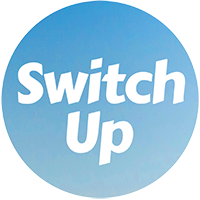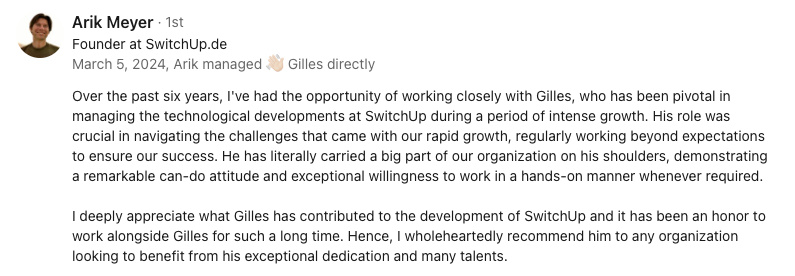Embracing a Hands-On Approach as a Chief Technology Officer
Abstract:
A hands-on Chief Technology Officer (CTO) is deeply involved in day-to-day operations and collaborates closely with the technical team, fostering a culture of accountability and innovation. They play a crucial role in grounding ambitious ideas into practical execution, embracing change and innovation in the rapidly evolving tech landscape. The CTO's impact is evident in the successful realization of ambitious tech projects, aligning the technology team's efforts with the company's strategic objectives. While direct involvement is beneficial, maintaining a balance and not losing sight of broader strategic goals is essential. Overall, a hands-on CTO is crucial for driving ongoing digital transformation and innovation in a fast-paced technological environment.
the modern role of a cto
Step aside, old-school executives! Today’s Chief Technology Officer (CTO) is more than just a figurehead waving from an ivory tower. This modern role demands someone who can bridge the daunting chasm between visionary strategy and the nitty-gritty of technical execution. Who knew tech could be this exciting, right?
So, what's the deal with a hands-on CTO? These tech gurus roll up their sleeves and dive straight into the heart of technology, working closely with their teams to ensure that high-level strategies don’t just stay on paper but translate into real-world solutions. By immersing themselves in the details, they foster an environment ripe for **innovation** and **accountability**. After all, a CTO who genuinely understands the technical trenches is better positioned to inspire and lead.
The value of such an approach becomes glaringly obvious when you consider the fast-paced nature of the tech industry: software updates, new programming languages, emerging trends— it’s enough to make your head spin! A hands-on CTO doesn’t just keep up; they actively **engage**, ensuring their company remains not only relevant but a step ahead.
Through this close collaboration with tech teams, a hands-on CTO can offer more than just strategic edicts. They provide guidance, mentorship, and yes, sometimes even jump in to squash the occasional bug. All these actions collectively create a culture where technical teams feel **supported** and **understood**. And let's be real, who doesn’t want a boss who actually gets what you do every day?
In essence, being a hands-on CTO isn’t just about *playing around with cool gadgets*. It's about aligning the broader goals with on-the-ground efforts, driving solutions that are both innovative and executable. So, let’s give a high-five to these trailblazers, leading the charge from the front lines of technology!
close collaboration with technical teams
The secret sauce of a hands-on CTO? Rolling up those sleeves and working shoulder-to-shoulder with their technical teams. But what does this collaboration look like in practice, and why does it matter so much? Let's peel back the layers on this fascinating dynamic.
engaging in daily operations
When we talk about daily operations, it’s easy to picture a CTO swooping down occasionally for grand strategy meetings. However, a hands-on CTO prefers to nestle right into the thick of things. This means being present in daily stand-ups, code reviews, and even impromptu brainstorming sessions over coffee. By maintaining a steady pulse on the team's activities, a CTO can provide timely feedback, spot potential challenges before they snowball, and, importantly, offer real-time support.
This daily engagement isn’t about micromanagement. Instead, it’s about cultivating a transparent and open environment. When team members see their CTO involved in the trenches, they know they can approach them with both small queries and big ideas. This accessibility demystifies the exec and transforms them from a distant figure to a trusted team member.
benefits of close collaboration
So, what’s in it for everyone when a CTO works hand-in-hand with their teams? The perks can be revolutionary:
- Enhanced accountability: When the top brass is visibly engaged, it sets a precedent for the entire team to follow. Engineers and developers feel a heightened sense of responsibility knowing that their CTO is right there, experiencing and addressing challenges alongside them.
- Stronger innovation culture: Innovation flourishes in environments where ideas flow freely and are acted upon quickly. A hands-on CTO offers a direct channel for creative ideas to be nurtured and developed. Plus, who doesn’t love to brainstorm with someone who’s an expert and enthusiastic about tech?
- Increased trust and morale: Trust is built when leadership demonstrates genuine involvement and understanding. When a CTO steps into the technical pit, it sends a powerful message that they care about the work and the workers. This trust is invaluable in maintaining high team morale.
aligning efforts with strategic objectives
A hands-on approach significantly aids in aligning the technical team's efforts with the company's broader strategic goals. It's one thing to have a vision; it's another to ensure every cog in the machine understands and works towards it. Here’s how direct involvement can streamline this process:
- Clear communication of goals: Instead of filtering strategies through layers of management, a hands-on CTO communicates goals directly to the team. This clarity ensures that everyone understands the why behind their tasks and how their work contributes to larger objectives.
- Real-time adjustments: Strategy isn’t static. As market conditions and technologies evolve, so too must the company’s approach. A CTO with a close collaborative style can quickly pivot plans, ensuring the team adapts without missing a beat.
- Hands-on mentorship: Direct involvement allows the CTO to mentor team members effectively, sharing insights and experiences that help the team grow both technically and professionally.
To offer an example, imagine a scenario where a new programming language emerges as a game-changer. Instead of merely sending an email announcing the shift, a hands-on CTO might initiate a workshop series, dive into coding sessions with the team, and support the transition by offering practical, on-the-ground guidance. This proactive approach not only smooths the transition but also demonstrates unwavering support, reinforcing the team’s confidence and cohesion.
the heart of collaboration
In the grand tapestry of a company’s operations, a hands-on CTO is the thread that weaves together strategic vision and day-to-day execution. By engaging deeply with their technical teams, they ensure that the broader picture painted by the company’s objectives aligns beautifully with the brushstrokes of daily technical work.
So the next time you see a CTO fiddling with code snippets or joining a late-night debugging session, know that it’s more than just a love for technology. It’s a commitment to fostering a cohesive, accountable, and innovative team that’s equipped to turn visionary strategies into reality. And hey, if it means getting to play with some cool gadgets along the way, that’s just an added bonus, right?
balancing hands-on involvement with strategic vision
It’s a classic conundrum: how does a CTO juggle being in the trenches while keeping an eye on the horizon? Striking the perfect balance between hands-on involvement and maintaining a bird’s-eye view of the company’s strategic goals can be as tricky as solving a Rubik’s cube blindfolded. But fear not—there are ways to manage this intricate dance without losing sight of either end of the spectrum.
avoiding the day-to-day trap
Even the most dedicated CTO can get lured into the daily grind, but it’s crucial they don’t get bogged down in the weeds. To avoid this trap:
- Delegate effectively: Trust is essential. Empower senior engineers and project managers to handle routine operational tasks. By delegating tasks appropriately, the CTO can stay involved without being overwhelmed by minutiae.
- Stay disciplined with time: Allocate specific blocks of time for hands-on work and strategic thinking. Using a well-structured calendar helps ensure that neither aspect overshadows the other. Think of it as a diet—balance is key!
- Regular check-ins: Weekly or bi-weekly check-ins with different departments can keep the CTO informed about ongoing projects while allowing time to address strategic directions without micromanaging.
maintaining the big-picture perspective
While it’s vital to be hands-on, keeping a clear view of the company’s long-term objectives is equally important. Here’s how to maintain that aerial perspective:
- Set clear priorities: Define and communicate the company’s vision and mission clearly. This ensures that all hands-on activities are aligned with overarching goals and prevents the CTO from getting sidetracked.
- Engage in strategic forums: Participate in executive meetings, industry conferences, and thought leadership events. These forums provide insights into industry trends and competitor strategies, helping keep the strategic vision sharp and relevant.
- Focus on metrics: Use performance metrics and KPIs to keep tabs on both technical performance and strategic progress. A balanced scorecard can help bridge the gap between daily operations and long-term objectives.
leveraging technology for balance
Yes, even the CTO can leverage technology to streamline their workflow. Tools and platforms designed for project management and communication, such as Slack, Jira, or Asana, enable the CTO to monitor progress efficiently without getting entangled in every detail. Utilizing these tools ensures that the CTO remains accessible and informed without compromising their view of the horizon.
To illustrate, think of a CTO who regularly reviews code with their team but also uses analytics dashboards to track project milestones. They might spend their mornings in meetings discussing strategic partnerships and afternoons coding or mentoring. This balancing act ensures they remain grounded while steering the ship towards its long-term destination.
By understanding the importance of balance and employing these strategies, a CTO can effectively bridge the gap between hands-on work and strategic vision. After all, it’s not just about juggling tasks—it’s about performing a well-rehearsed ballet where each move is deliberate, poised, and beautifully aligned with the company’s overarching aspirations. And hey, if it occasionally means swinging from one to the other, at least it keeps the job interesting!
driving digital transformation and innovation
The role of a hands-on CTO in driving digital transformation and fostering innovation is nothing short of pivotal. These individuals don't just nudge their organizations towards modernity; they catapult them headfirst into the future with enthusiasm and agility. Let’s break down how they make this magic happen.
adapting like a tech chameleon
In a world where technology changes at the speed of light, adaptability isn't just a nice-to-have; it’s a necessity. A hands-on CTO exemplifies this trait by continuously learning and evolving with the industry. They're like tech chameleons, blending seamlessly with new languages, frameworks, and tools, and bringing these innovations back to the team. Take inspiration from Satya Nadella, Microsoft’s CTO turned CEO, who famously said, "Our industry does not respect tradition— it only respects innovation." This mindset reflects the essence of a hands-on CTO’s philosophy.
embracing change fearlessly
A hands-on CTO thrives in an environment of constant evolution. They don’t just ride the wave of change; they create it. By championing emerging technologies and practices, they foster a culture that celebrates innovation. This could be introducing agile methodologies, exploring machine learning applications, or integrating AI-driven analytics. It's all about ensuring the company isn’t just keeping pace but setting the tempo for others to follow.
Consider the case of Werner Vogels, Amazon’s CTO, who emphasizes the importance of experimenting and taking risks: "Everything fails all the time. We need architectural principles that allow us to absorb failure on a regular basis." His perspective underscores how essential it is for a CTO to embrace change and see failure not as a setback but as a valuable learning opportunity.
cultivating a culture of innovation
Creating an innovation-friendly environment means providing the right tools, fostering open communication, and encouraging creative thinking. A hands-on CTO does more than just grant permission to innovate; they lead by example. They might pilot experimental projects, host hackathons, or encourage cross-departmental collaborations. These actions signal to the entire organization that innovation isn’t a department—it’s a collective state of mind.
driving strategic digital initiatives
At the heart of digital transformation is a series of strategic initiatives orchestrated by the CTO. These projects often involve overhaulating legacy systems, integrating cloud solutions, automating processes, or deploying cutting-edge cybersecurity measures. A hands-on CTO ensures these initiatives aren't just boardroom buzzwords but tangible, actionable strategies that permeate every level of the organization.
For instance, when Google’s CTO, Urs Hölzle, led the push towards cloud services, he didn’t just oversee the project from afar. Hölzle was actively involved in its development, which not only expedited its implementation but also inspired confidence across the team.
championing customer-centric innovation
Successful digital transformation isn’t just about internal advancements; it’s about delivering unparalleled value to the customer. A hands-on CTO keeps the end-user at the forefront of innovation efforts. They constantly seek feedback, analyze user data, and stay attuned to customer needs. This proactive approach ensures that the company’s technological strides translate into enhanced user experiences and customer satisfaction.
balancing long-term vision with short-term wins
While a hands-on CTO is deeply involved in immediate technical challenges, they never lose sight of the long-term vision. They understand that digital transformation is a marathon, not a sprint. By setting incremental goals and celebrating short-term wins, they maintain momentum and morale, gradually steering the ship towards grand horizons.
Ultimately, the role of a hands-on CTO in driving digital transformation and innovation is a blend of art and science, a dance of strategy and execution. Their ability to embrace change, foster an innovation-centric culture, and lead with both vision and involvement makes them invaluable. And if they can do all this while tossing in a bit of humor and levity to keep the team’s spirits high? Well, that’s just the cherry on top of the innovation sundae!
the lasting impact of a hands-on cto
A hands-on CTO leaves an enduring mark on an organization by seamlessly integrating high-level strategy with actionable technical insight. Throughout this article, we’ve highlighted the many facets that make this role indispensable in the tech and engineering sectors.
Firstly, by closely collaborating with technical teams, these CTOs foster an environment ripe for innovation and accountability. This isn’t about micromanagement but about being present where it matters. Their involvement enhances team morale and ensures a transparent flow of ideas and feedback.
Secondly, balancing hands-on involvement with strategic vision is crucial. Our tech leaders manage this balancing act with effective delegation, disciplined time management, and a focus on big-picture priorities. These practices allow them to keep one foot in the code and the other in the boardroom—quite the juggling act!
Next, driving digital transformation and innovation is where the hands-on approach truly shines. By staying adaptable and embracing new technologies, these CTOs lead their companies into the future. They don't just adopt change; they champion it, turning potential disruptions into opportunities for growth.
The lasting benefits of a hands-on CTO are profound. They create a culture of trust, foster an environment where innovation thrives, and ensure that strategic objectives align seamlessly with daily operations. It's a role that blends the art of leadership with the science of technology, leaving a lasting legacy of success. And let’s be honest, who wouldn’t want a tech-savvy, gadget-loving leader guiding their company to new heights?
You might be interested by these articles:
- Redefining Care: Datafication's Impact in Healthcare
- Enhancing Data Privacy with Federated Learning
- The AI Woke Police vs. The Irony Brigade: Can Robots Understand Sarcasm?
- Laughing with AI: Navigating the Ethical Maze of Artificial Humor in Branding
- The Symphony of Creativity in an AI-Powered World





